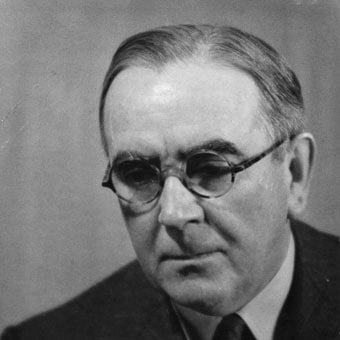
John Ireland
d. 12 June 1962, Washington, Sussex
John Ireland was born on 13 August 1879 at Bowden, Cheshire, into a highly cultured environment (though his parents’ interests were literary rather than musical). His initial education was at Leeds Grammar School, but when he was fourteen he moved to London, which was to remain his home for most of the next six decades. He studied piano at the Royal College of Music in London from 1893 to 1897, continuing at the College until 1901 as a composition scholar, under Sir Charles Villiers Stanford. At the age of sixteen he was awarded a fellowship at the Royal College of Organists, the youngest student ever to do so, and organ was his second study at the College, under Sir Walter Parratt. His fellow students at the RCM included Vaughan Williams and Holst. He took his Ph.D. from Durham University in 1906, and was later (1932) to be awarded an honorary doctorate there.
From 1904 until 1926 Ireland held the post of organist at St Luke’s, Chelsea, which allowed him time to compose. He also gained a strong reputation as a much-respected teacher. Soon after the end of the First World War he joined the staff of the Royal College of Music as Professor of Composition, a position he held for many years; his pupils there included talents as diverse as those of Benjamin Britten, E. J. Moeran, Richard Arnell, Alan Bush and Humphrey Searle. His involvement in music education took other forms, too: he was a music examiner and ‘Inspector of Music in Schools’ for the Associated Board of the Royal Schools of Music.
Ireland had a long association with the Channel Islands, and he took advantage of a request to design an organ in a church on Guernsey to insist that he should be the organist and choirmaster. He took up the post just before the outbreak of the Second World War, and narrowly escaped after the German invasion: he was one of the 1,500 people crammed onto the last boat to make it back to the British mainland. He settled in Chelsea again after the War but left London in 1953 to live in a converted windmill on the West Sussex Down, opposite the Chanctonbury Ring. Here he spent the rest of his life; he died on 12 June 1962, two months short of his 83rd birthday.
Ireland had been composing since boyhood but, fiercely self-critical, he destroyed all his early works; the earliest surviving work in his catalogue therefore dates only from 1903. Ireland’s imagination was always stimulated by images, particularly of landscapes. One of his best-known piano pieces, The Island Spell, was inspired by a warm summer’s day on Jersey in 1912. Jersey also lay behind the orchestral prelude The Forgotten Rite (1913), and the historical images of the South Downs brought forth the symphonic rhapsody Mai-Dun (1921). Though suffering some neglect in his later life, during the central part of his career he was one of the most widely performed of British composers, with smaller-scale works – his songs and chamber music – attracting the most attention. His Second Violin Sonata made such an impact on its first performance that the first edition was sold out even before it was published. His song Sea Fever (1913), to a text by Masefield, is still one of the best-known British art-songs. His church music swiftly entered the repertoire and was sung throughout Britain. And for many years his Piano Concerto (1930) was a favourite at the Proms.
Ireland’s sensitive music reflects the personality of its composer: it is unemphatic and meticulous, with a peculiarly English quality of emotion expressed through reserve. The signs of renewed interest include a complete recording of his songs, which in many ways encapsulate the essential Ireland.
John Ireland is published by Boosey & Hawkes.
This biography can be reproduced free of charge in concert programmes with the following credit: Reprinted by kind permission of Boosey & Hawkes
